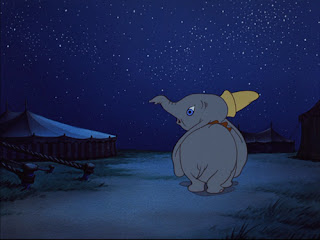Studying background paintings I often wonder why certain colors were chosen and not others. The obvious answer would be: because they make the picture look good. But why does it look good, what thoughts could have led the artist to favor certain colors? The artist might have followed his intuition, but it's still possible to deduce underlying concepts. There are color schemes of all kinds, some of them expressionistic, some impressionistic. But even realistic looking backgrounds are not composed by simply copying nature. The thinking behind these color choices is just not as obvious.
When I revisited Bongo I noticed how much more expensive the artwork in this film looked compared to Dumbo. Although it is still essentially an overlong cartoon, the backgrounds are painted in a more realistic style. The funny thing is that Bongo dreams in a slightly more stylized way. Once he is free, the forest backgrounds are drawn more realistically. There are cast shadows throughout, though.
dream vs. reality
 Brown bears and grey trees
Brown bears and grey treesBongo himself is plain brown with red clothes (balanced by primary yellow and blue).
 The subdued background colors are based on yellow, green, blue and grey, leaving room for both brown and red. There are hints of warm red (and therefore brown) in many colors (as always we don’t really know what the original prints looked like), but the absence of full warm brown becomes evident especially in the tree trunks. In front of these grey trees the saturated brown bears and squirrels are easily distinguished. Basically the characters are more saturated than the backgrounds. Note that Disney's 1940s and 1950s backgrounds almost always have a strong pool of light and some very dark receding areas with little detail that provide the picture with a sense of depth.
The subdued background colors are based on yellow, green, blue and grey, leaving room for both brown and red. There are hints of warm red (and therefore brown) in many colors (as always we don’t really know what the original prints looked like), but the absence of full warm brown becomes evident especially in the tree trunks. In front of these grey trees the saturated brown bears and squirrels are easily distinguished. Basically the characters are more saturated than the backgrounds. Note that Disney's 1940s and 1950s backgrounds almost always have a strong pool of light and some very dark receding areas with little detail that provide the picture with a sense of depth.original frame as it appears on the DVD
oversaturated frame in order to distinguish the hues more clearly
warm colors (Bongo) against colder colors (tree)
Grey trees also provide a desaturated backdrop for the more saturated characters and blend in with the rest of the neighboring background colors.
Note that the tree trunk in the foreground is brown in contrast to the grey unimportant background parts. The contrast to Bongo is merely a case of value and saturation. It’s not important how well we see his feet here, the interesting part is his sad overall expression with the focus on the face.
The more blue the grey contains the colder and more distant does it feel.
In shots without visible blue sky this aerial perspective separates the planes beautifully. The blue background also provides better contrast of hue to the surrounding brown bears.
In the end when the bully Lumpjaw (according to Borge Ring via Michael Barrier a caricature of Dave Hand) is conquered, the forest is depicted in warm evening light that is far more saturated.
In the end, blue mountains and the sky provide the image with cold-warm hue contrast. Color-wise Bongo and Lulubelle are united with the warm trees. This is the first time Bongo succeeds in climbing a tree - with the help of his little forest friends, of course. On the right, the darker Bongo is on the brighter side of the tree making for nice contrast of value.
Since pink is the color associated with Bongo's love dreams there is one instant where pink is part of a background:
When Bongo sees Lulubelle for the first time, he is not sure if he's dreaming. It also makes sense that a girl wearing a pink flower is first seen framed by such flowers. The yellow and white flowers are everywhere but they don't stand out the same way because of their closeness to the general background hues.
Variations on a theme
There are many mass scenes with assorted bears. Their design varies to a certain degree but is never consistent from shot to shot. Essential in giving the impression of a large variety of bears is their different coloring. To unite them they are all different shades of brown ranging from Lumpjaw’s cliché darkness to Lulubelle’s salmon color.
It goes unnoticed that the colors change in every shot because they are always in the same range. Although the middle and right image are shots from the same scene the bears differ greatly.
Sometimes the darker bears are those in the shadow that shouldn’t attract our attention (see further above where they circle Bongo and Lulubelle), sometimes the darkness is a means of separating dance groups.
When Lumpjaw is not in the shot they are often intermingled for balanced variety. They are male or female according to what’s called upon. Males seem to be darker.
If you are interested in the thinking that went into "naturalistic" backgrounds of Bambi and Lady and the Tramp I suggest you visit Hans Bacher's Animation Treasure Blog.
All screenshots taken from the 2003 DVD edition.






















































